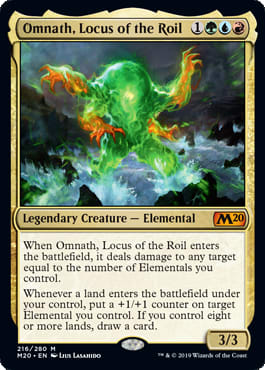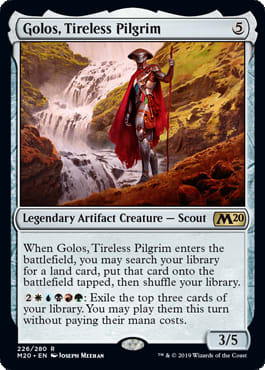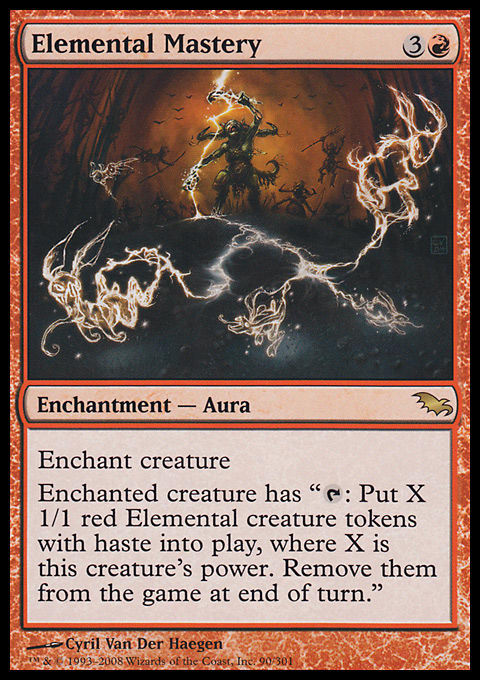Two previously unrelated ideas came together in my head to lead to this article and the first was actually building my Omnath, Locus of the Roil deck. In my article, I said I wanted to reconcile my Tatyova, Benthic Druid deck and my Omnath, Locus of Rage deck. In reality, I didn't have a Locus of Rage deck put together to take apart and not only did that mean buying singles for my own deck (the OPPOSITE of what you're supposed to do in mtg finance) it involved having to find inspiration for the deck elsewhere. Since my wife doesn't play EDH with me much anymore, I didn't feel bad taking apart her Omnath, Locus of Mana deck (this is getting pretty confusing with the names, so I'm going to start saying "Green" "Gruul" and "Temur") and using some of its parts to build the new Omnath deck that she's welcome to if she ever decides to play again. Tearing Green Omnath apart revealed that there was a ton of overlap between the Green parts of Tatyova and the core of the Omnath deck and it made me realize that those cards all did the same "thing."
The second idea stemmed from attempting to write an article about Golos, Tireless Pilgrim for this week. Golos is becoming quite popular - it's ranked third this week on EDHREC just behind, you guessed it, Yarok, the Desecrated and Kykar, Wind's Fury. Golos is a dirty cheater, letting you play spells for free with an activation, but in a way that's much more exciting than Jodah, Archmage Eternal. You have the element of surprise, especially if you don't add cards like Brainstorm, Scroll Rack, and Future Sight. This random element is very 75% because you can add some inconsistency to make the deck more fun for weaker decks to play against but maintain a high power level of your cards making it non-miserable to play against people who built more seriously. A deck that can windmill an Omniscience, Emrakul, the Promised End, and It That Betrays but can also windmill a Farseek, Gruul Signet, and Basic Swamp is aces in my book. Digging into how I was going to approach Golos, I realized that not only was I opting for the same Green "kit" in Green Omnath, Tatyova, and, ultimately, Temur Omnath, I was looking to do the same things in Golos. Was this something about me as a builder that was subtly manifesting itself in my decks all along? Can we learn anything from this tendency? Either way, I scrapped a 2/3rds written Golos article and started over from scratch because I think this discovery is likely to bear more meaningful fruit than me giving you a Golos list that was somewhat chaotic and unpredictable. Here's some homework - think of a 75% Golos list on your own. You're not going to do it because I called it homework, are you? That's fine. Don't make a whole deck, that's crazy. I mean, unless you were going to build Golos anyway and wanted to do it 75%.
If you've never read the 8 Simple Rules article now is a good time to read it and think about some of our core tenets. How would you approach Golos from a 75% perspective? I gave some hints already - we want to avoid knowing what's on top of the deck, we want to have high-powered cards to make good "surprise" payoffs from Golos activations and we want to make sure enough of the deck is dedicated to developing our goofy mana base.
I don't want you to think that the concept of a "staple" is just now occurring to me - I think that identifying cards I (or you, or anyone) try to always include in decks could give some insight into how 75% works and how I try to build decks in a first draft and maybe lead myself down dead ends. This goes beyond staples, in fact, I think this is the opposite. Staple cards that always go in certain colors or styles of decks actually reduce the amount of "flex" cards we get and if we take them away, we're left with our signature as a deck-builder. I would estimate we only get 5-15 flex cards on a good day. Let's take a Golos deck while we're thinking about Golos. This is just the "average" deck generated by EDHREC, it doesn't matter a ton what the deck is, we're using it for illustrative purposes.
EDHREC Average Golos | Commander | Jason Alt
- Commander (1)
- 1 Golos, Tireless Pilgrim
- Creatures (20)
- 1 Avenger of Zendikar
- 1 Azusa, Lost but Seeking
- 1 Courser of Kruphix
- 1 Deadeye Navigator
- 1 District Guide
- 1 Eldrazi Displacer
- 1 Eternal Witness
- 1 Gatecreeper Vine
- 1 Maelstrom Wanderer
- 1 Mina and Denn, Wildborn
- 1 Muldrotha, the Gravetide
- 1 Oracle of Mul Daya
- 1 Ramunap Excavator
- 1 Solemn Simulacrum
- 1 Soulherder
- 1 Tatyova, Benthic Druid
- 1 The Gitrog Monster
- 1 Ulvenwald Hydra
- 1 Wayward Swordtooth
- 1 Yarok, the Desecrated
- Planeswalkers (2)
- 1 Aminatou, the Fateshifter
- 1 Lord Windgrace
- Instants (9)
- 1 Anguished Unmaking
- 1 Brainstorm
- 1 Crop Rotation
- 1 Cyclonic Rift
- 1 Enlightened Tutor
- 1 Ephemerate
- 1 Mystical Tutor
- 1 Swords to Plowshares
- 1 Vampiric Tutor
- Sorceries (14)
- 1 Circuitous Route
- 1 Cultivate
- 1 Demonic Tutor
- 1 Farseek
- 1 Hour of Promise
- 1 Kodama's Reach
- 1 Life from the Loam
- 1 Open the Gates
- 1 Pir's Whim
- 1 Rampant Growth
- 1 Scapeshift
- 1 Splendid Reclamation
- 1 Sylvan Scrying
- 1 Tempt with Discovery
- Enchantments (7)
- 1 Burgeoning
- 1 Exploration
- 1 Guild Summit
- 1 Rhystic Study
- 1 Smothering Tithe
- 1 Sylvan Library
- 1 Zendikar Resurgent
- Artifacts (9)
- 1 Chromatic Lantern
- 1 Commander's Sphere
- 1 Conjurer's Closet
- 1 Crucible of Worlds
- 1 Expedition Map
- 1 Fellwar Stone
- 1 Panharmonicon
- 1 Sensei's Divining Top
- 1 Sol Ring
- Lands (38)
- 1 Plains
- 1 Swamp
- 2 Island
- 5 Forest
- 1 Azorius Guildgate
- 1 Blood Crypt
- 1 Bojuka Bog
- 1 Boros Guildgate
- 1 Breeding Pool
- 1 Cascading Cataracts
- 1 Command Tower
- 1 Dimir Guildgate
- 1 Exotic Orchard
- 1 Field of the Dead
- 1 Gateway Plaza
- 1 Godless Shrine
- 1 Golgari Guildgate
- 1 Gruul Guildgate
- 1 Hallowed Fountain
- 1 Izzet Guildgate
- 1 Maze's End
- 1 Orzhov Guildgate
- 1 Overgrown Tomb
- 1 Rakdos Guildgate
- 1 Sacred Foundry
- 1 Selesnya Guildgate
- 1 Simic Guildgate
- 1 Steam Vents
- 1 Stomping Ground
- 1 Temple Garden
- 1 Thespian's Stage
- 1 Watery Grave
- 1 Windswept Heath
*(the average number of Mountains was 0.4 or lower, so the value assigned is 0. That's funny to me)
Your lands are not really flex cards. You can add utility lands and you can even have "signature" utility lands. Any deck I play that includes Tatyova (That's going to include Omnath, Golos, and basically any deck with Blue and Green mana at this point) will have Ghost Town if I can reasonably swing colorless lands in a five-color deck. That doesn't change the fact that lands always go in the decks and you can monkey with the number but not with the concept. This deck runs 42, most decks run between 34 and 45 depending on how much a Tayova-based deck it is. Let's say the average is 40 (it isn't, and per EDHREC data, the average number of lands in a deck is dropping every year). 40 lands and a commander down - that's 58 spots. We lost a little under half of our potential flex spots in the first cut. It gets worse.
Every deck has Sol Ring. 57. Golos is five colors. Chromatic Lantern, Fellwar Stone, Commander's Sphere, Expedition Map. 53. We're losing ground fast. Azusa, Lost But Seeking, Courser of Kruphix, Gatecreeper Vine, Kodama's Reach. When you pare away the really important cards in the deck, using this list as a basis for a 75% deck would really only leave me the following cards to cut and replace.
- 1 Brainstorm
- 1 Enlightened Tutor
- 1 Mystical Tutor
- 1 Vampiric Tutor
- 1 Demonic Tutor
- 1 Scapeshift
- 1 Splendid Reclamation
- 1 Sylvan Scrying
- 1 Tempt with Discovery
- 1 Sensei's Divining Top
- 1 Aminatou, the Fateshifter
Everything else seems mostly essential to the deck functioning, and I'm being pretty subjective in that I mostly yanked out the cards that make the deck consistent. We could quibble over a few of the creatures and it's true you could make a case for cutting or keeping nearly every one of the creatures in the average deck, but starting with a built deck and paring it down, we don't get a ton of spots to work with. I suspect it works that way building from the ground up, too.
When I was trying to reconcile the Green Omnath and Tayova decks to build Temur Omnath, I had two copies of a lot of cards. Azusa, Courser, Wayward Swordtooth, Summer Bloom, Avenger of Zendikar. Cards like this formed the nucleus of a lot of my Green decks and the larger the list of "must-play" cards grew, the less space I had to be creative and build around the commander. Does it hurt that Omnath and Tatyova and other Omnath all want to put a lot of lands into play? Probably not. But when I got done including cards just from Green Omnath and Tatyova, I basically had no room for Red. That's a problem, because I like the idea of including Cavalier of Flame and I was basically splashing Red at this point.
I see deck-building tips like 8x8 which have you find 8 categories and include 8 cards from each category to make sure everything is represented. I think that's a good tip for people who don't build decks often or who, left to their own devices, would forget things like ramp and card draw. I don't want to make any numerical rules for myself; but, in general, I want to find more room for flex cards without just taking a deck that works and then taking out the tutors and jamming in Bribery and Thada Adel, Acquisitor. I want my flex spots to actually work with the commander. What I think it's vital to do and doubly vital to do in a 75% deck is make sure there is a "thing" you're trying to do. Something either fun or powerful or silly or otherwise important to you. When I look at Omnath, Locus of the Roil, I want to do more than just dump lands into play because the deck benefits from that and then slap the counters on an Elemental because I can. For me, I want to throw Elemental Mastery on a creature, preferably Omnath, Locus of Rage and make a ton of Elementals. Elemental Mastery is pretty weak when I don't have Omnath, Locus of Rage as a payoff card unless I support it somehow. I did the same combo in Gruul Omnath before, but now I have Blue. How can Blue benefit me? Well, Blue gives me access to Intruder Alarm, for one, and with Paradox Engine gone, Intruder Alarm is the next best thing. We don't want Intruder Alarm just there to support Elemental Mastery, though, so we need to make sure we have other payoffs. How about Incandescent Soulstoke? If you have enough mana, you can dump your entire hand with Intruder Alarm out. It's good with Rakka Marr, also. Your mana creatures get a lot better, so maybe we should include another mana dork or two in the place of Brighthearth Banneret since reducing mana cost and generating mana is similar-ish on paper but one combos much better with Alarm. Instead of starting at 100 (or 200, when reconciling two decks like I was) and paring down a few flex spots, I want to decide what my core package is before I do anything else. I don't want to carve out a few spots for the cards that are most important to me, I want to get as many of them into the deck as I can, and if I can find room for Courser of Kruphix later, so be it. The core of the deck isn't your staples, it's the cards that made you want to play the deck in the first place. Sakura-Tribe Scout is better in an Intruder Alarm deck than Burgeoning is but I would have included Burgeoning if I had started with the cards from both decks and pared down. I had to remind myself of a lesson I already covered 3 years ago when I discussed the concept in Chemistry known as the Aufbau Principle. We want to start from nothing and build up, and going in with a preconception of what cards have to go in a deck like this, where lands coming into play matters, isn't really building from the ground up, is it? If you assume you have a Commander, 40 lands, a Sol Ring and a huge, Green pile of lands matter staples, you're really squeezing out the cards you care about without knowing it.
Building around one simple thing I want to do with Elemental Mastery, which may or may not be good (it's very good with either Omnath considering the Commander can dump counters on a creature to make Elemental Mastery stronger and Gruul Omnath domes them when the creatures die) makes me feel a lot better about the deck. Starting from Elemental Mastery as card #1 rather than something I have to cut cards to make room for, I came up with -
- Intruder Alarm
- Purphoros, God of the Forge
- Rakka Marr
- Parallel Lives
- Impact Tremors
- Overgrowth Elemental
- Somberwald Sage
- Sakura-Tribe Scout
- Incandescent Soulstoke
- Retreat to Coralhelm
- Kiora, Behemoth Beckoner
- Prime Speaker Vannifar
- Cryptolith Rite
Will all of these cards make the deck? Probably not, but when you start with this sort of a nucleus and build the deck around it, you're not going to end up with a samey-feeling deck. I felt like I was going to play my copy of Azusa, Lotus Cobra, Courser and Wayward Swordtooth in a deck so it could either be Golos or Omnath and now I feel like I have a direction I want to take Omnath, finally. I don't know if this approach is more or less important in a 75% deck but I do know that I'm going to try and remember to stick to it in the future. If you'll excuse me, I have to go order an Intruder Alarm.
Do you build your decks a certain way to make sure you include everything you need? 8x8? Some other method? Does my nuclear (or nougat, whichever you prefer) approach give you any clarity? Leave it for me in the comments section. I'll be back with another deck idea before you know it. Until next time!
























